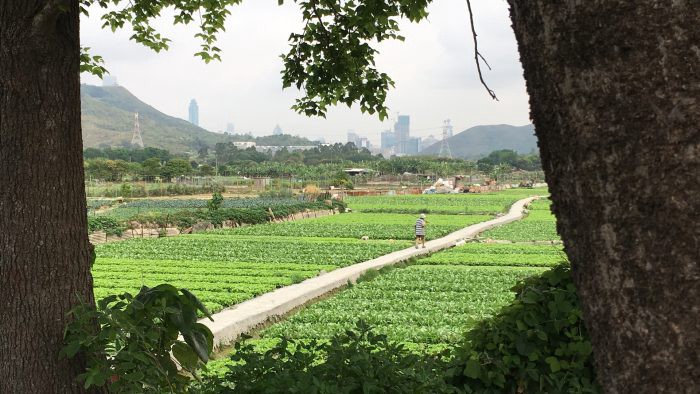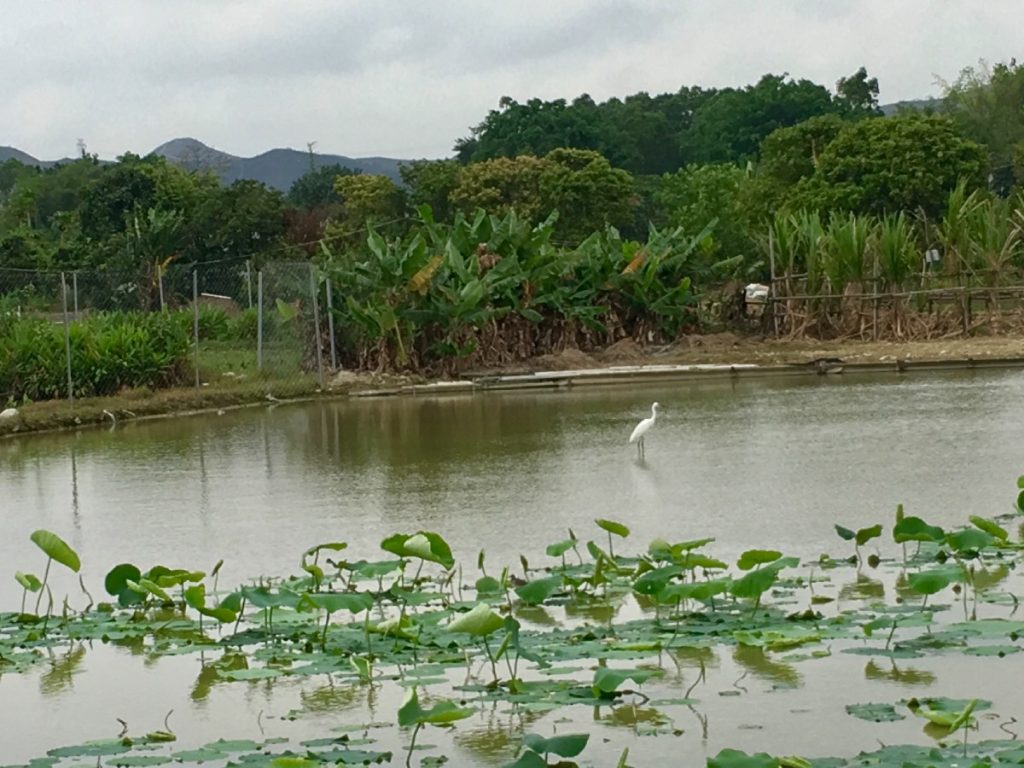In this semester I assist in teaching a course on the regional geography of Hong Kong and the Pearl River Delta. This course, designed and instructed by Professor Tang, covers various geographical aspects of the region, such as development, environment, economy and boundary. Last Tuesday (11th April), this course invited Professor Kenneth Wong to lead us a field trip, taking the students to Yin Kong Village in Sheung Shui (in the Northern part of Hong Kong) to have an on-site inspection of the landscape of Long Valley.

Long Valley is a wetland bounded by rivers (yet, they are nowadays channelised), attracting over two hundred species of birds as lots of them stop over in this place during the process of bird migration. It is an agricultural farm – of the few still left – in Hong Kong. Although we didn’t encounter any photographers this time, I remember in our last visit a year ago we saw some people who were covered with camouflage cloth taking photos of birds with long-lens cameras and tripods.
Standing there, you can see the high-rise cityscape of Shenzhen. Several hundred thousand people moving across the border at Lok Ma Chau Station pass through the Long Valley daily, although they might not notice this landscape because they go underground. And, this is the outcome after rounds of negotiations and debates when the proposal of constructing the Lok Ma Chau Spur Line was put on the agenda in the late 1990s.
The Government proposed the new spur line in the 1990s to enhance the cross-border mobility between Hong Kong and China, and the railway corporation (KCRC, currently merged with MTR) was invited to submit a proposal in 1998. In the same year the Environmental Impact Assessment has started to become a statutory requirement for construction projects. It was proposed to connect Sheung Shui Station and Lok Ma Chau Station with a viaduct across the Long Valley. This proposal received a lot of criticisms from environmental concern groups for its potential damage to the biodiversity and ecology, and, consequently, was unable to obtain the environmental permit from the Director of Environmental Protection because of the disapproved environmental impact assessment report. This controversial debate was then followed by rounds of appeal, resubmission and rejection, and came to the end with the alternative solution of constructing a tunnel instead of a viaduct across the Long Valley in 2001. Even though the construction of tunnel and the channelisation of rivers have changed the water ecology of the wetland and the farmers needed to take actions to mitigate the changes, the environmental harms to the landscape and the biodiversity were minimised with the updated proposal which was completed in 2007.
From this field trip we gained some ideas of how policy and statutory tools can help protecting the environment, and at the same time facilitating the ‘development’. Keeping these ideas in mind, something in this week’s TIME magazine (17th April issue) caught my attention.
Since the last month, in New Zealand and India, there have been four new legal persons recognised by courts. These are not the legal persons we commonly understand such as government, business corporations or NGOs. They include the most famous Himalayan Glaciers, as well as rivers threatened by pollutants, namely Whanganui River in New Zealand, Ganga River and Yamuna River in India. Each of these natural rivers were given legal rights to become an entity having a legal standing: they can be involved in a lawsuit, either initiating a charge or being charged.
The journalist noted that these are in efforts to ‘curb environmental destruction’. The rivers are suffering from grave water pollution and the Glaciers are melting. The court ordered in the judgement that the Glaciers are declared to have the status of a legal person,
‘with all corresponding rights, duties and liabilities of a living person, in order to preserve and conserve them’.
The court added that the rights of the legal person shall be
‘equivalent to the rights of human beings and the injury/harm caused to these bodies shall be treated as harm/injury caused to the human beings’.
The court has also declared a number of people including government officials, academics and environmental projects representatives in the place of parenting the Glaciers.
Conventionally, being a legal person does not mean being entitled to human rights. However, recent court cases in some common law jurisdictions have witnessed the discussion on whether legal persons such as business corporations should be treated with human rights. In the United States, for example, the court has recognised a profit-making closely held corporation’s claim for religious right. This debate is still on-going and it is interesting to keep an eye on what will happen.
Source of law in common law system
As same as Hong Kong, New Zealand and India are both common law jurisdictions. It has been a usual practice that the environment is protected through a few legitimised measures such as statutory environmental impact assessments or market mechanism (for instance, carbon trading). These measures are rooted in the public trust doctrine in the common law system for a very long period of time.
Historically private property owned by individuals and common resources held by Monarch in inalienable trust (as influenced by Feudalism) have been distinguished from each other. This doctrine in ancient laws has later on become part of the common law system to ensure the public right to the lands which are common to everyone should be protected by the government. Central to the doctrine is to ensure, what can be called as, the human rights of the public to the lands, but not the rights of the lands themselves. This, of course, applies in Hong Kong. Hong Kong as a jurisdiction has formulated the tools to protect the environment. An instance is the New Nature Conservation Policy enacted in 2004, while Long Valley is classified as a priority site for enhanced conservation with the premise that the conservation is not harmful to private property right.

More symbolic than actual
The declaration of the nature as legal persons last month is unusual, because the legal acts were not ensuring the human rights of the public, but to ensure the rights of the lands! This is a tremendous symbolic change in the ideology of how we perceive the nature. Professor Kenneth Wong always shared with us one of his favourite quotes by Aldo Leopold,
‘We abuse land because we see it as a commodity belonging to us. When we see land as a community to which we belong, we may begin to use it with love and respect.’
Although ensuring legal rights of the lands does not mean too much if it lacks the enforceable policy institutions, this is still a great step along the road to sustainable development.
In the case of India, several persons and organisations are appointed to take up the role of parenting the legal person, in other words they act on behalf of it to protect the Glacier and clean up the rivers. The Indian Government is also setting up a new board to monitor its progress. New Zealand has also established a system in the government and prepared for certain funds to support the legal process. Whether the nature can protect themselves still depends on many factors: Will the appointed agents really try their best to fight for the legal rights of the nature, and in what ways? What is the best (, or the better) legal process and framework in facilitating the protection of rights? Do we need further relevant legislations? This does not only take time, but also depends on the power relations in the legislation system, on the potentially harmed and benefited interests of different parties, and on the public in the society.
Going back to the case of Long Valley, is there any possibilities that Long Valley would be treated as a legal person? Hong Kong for a long time upholds the belief in development. The one who claimed power in the regime protect their interests as capitalists. After the transfer of sovereignty, New Territories where Long Valley is situated is particularly important in terms of geopolitics between Hong Kong and China. Our attitude towards the environment conservation is more than a mere discussion on the legal or the natural.
What it all comes down to is still the politics.